Numerical Model and Experimental Analysis of the Thermal Behavior of Electric Radiant Heating Panels
Abstract
:1. Introduction
2. Materials and Methods
2.1. Radiant Heating Panel
- Surface coating
- Electric heaters
- Insulating layer
2.2. Mathematical Model
- the specific heat flux [Wm−2] generated on the surface by Joule effect is given by:being I[A] the electric current and R[Ω] the electrical resistance;
- the heat flux exchanged with the ambient at TAMB = T0 by convection is:
- the heat flux exchanged with the ambient at TAMB = T0 by radiation is:
2.3. Experimental Layout–Thermal Testing
- 4 contact temperature sensors for the walls, one for each of the four outer walls of the test chamber;
- 4 air temperature sensors placed near the side of the entrance door of the test chamber at 0.1 m, 1.1 m, 1.7 m, and 2.5 m height;
- 4 air temperature sensors placed near the opposite side of the entrance door of the test chamber at 0.1 m, 1.1 m, 1.7 m, and 2.5 m height;
- 4 air temperature sensors placed in the climatic room that encloses the test chamber (one for each side of the cell);
- 1 contact temperature sensor placed on the floor of the test chamber;
- 2 temperature sensors placed on the radiant ceiling, one at the inlet of a series of panels, the other one in a point of the ceiling not occupied by panels;
- 2 globe thermometers placed on the side of the entrance door of the test chamber and on the opposite side at the height of 1.1 m for the measurement of the average radiant temperature;
- 3 temperature sensors placed in the space between the radiant ceiling and the ceiling of the room, one in contact with the ceiling of the cell, one in contact with the radiant ceiling, one that measures the temperature of the air in the cavity.
2.4. Measurement Procedure
3. Results
3.1. Steady State Thermal Conditions
- (a)
- energy need for space heating (and as consequence from thermal properties of building envelope and indoor/outdoor boundary conditions);
- (b)
- non-uniform indoor air temperature distribution (i.e., due to stratification or plane radiant asymmetry);
3.2. Transient Thermal Conditions
4. Discussion
Acknowledgments
Author Contributions
Conflicts of Interest
Nomenclature
| Lx | Panel thickness [m] |
| Ly | Panel half length [m] |
| Lz | Panel half width [m] |
| V | Voltage [V] |
| P | Electrical Power [W] |
| I | Electric Current [A] |
| T | Temperature [K] |
| ρ | Density [kg m−3] |
| cp | Specific heat [J kg−1 K−1] |
| qE | Heat flux given by Joule effect [W m−2] |
| qCONV | Convective heat flux [W m−2] |
| qRAD | Radiant heat flux [W m−2] |
| t | Time [s] |
| R | Electrical resistance [Ω] |
| hCONV | Convective heat coefficient [W m−2 K−1] |
| hRAD | Radiant heat coefficient [W m−2 K−1] |
| ε | Emissivity [a.u.] |
| σ | Stefan-Boltzmann constant [W m−2 K−4] |
| Temperature average [K] | |
| θ | Laplace transform of the temperature |
| α | Panel asymptotic temperature [K] |
| τ | Time constant of the system [s] |
| TENV | Temperature of the environment [K] |
References
- Bean, R.; Olesen, B.W.; Kim, W.W. History of Radiant Heating & Cooling Systems, Part 2. ASHRAE J. 2010, 52, 50–55. [Google Scholar]
- Lin, K.; Zhang, Y.; Xu, X.; Di, H.; Yang, R.; Qin, P. Experimental study of under-floor electric heating system with shape-stabilized PCM plates. Energy Build. 2005, 37, 215–220. [Google Scholar] [CrossRef]
- Seo, J.; Jeon, J.; Lee, J.-H.; Kim, S. Thermal performance analysis according to wood flooring structure for energy conservation in radiant floor heating systems. Energy Build. 2011, 43, 2039–2042. [Google Scholar] [CrossRef]
- Miriel, J.; Serres, L.; Trombe, A. Radiant ceiling panel heating–cooling systems: Experimental and simulated study of the performances, thermal comfort and energy consumptions. Appl. Therm. Eng. 2002, 22, 1861–1873. [Google Scholar] [CrossRef]
- Andrés-Chicote, M.; Tejero-González, A.; Velasco-Gómez, E.; Rey-Martínez, F.J. Experimental study on the cooling capacity of a radiant cooled ceiling system. Energy Build. 2012, 54, 207–214. [Google Scholar] [CrossRef]
- Khanna, A. Development and Demonstration of a Performance Test Protocol for Radiant Floor Heating Systems. Available online: http://theses.lib.vt.edu/theses/available/etd-01182006-011730/ (accessed on 20 November 2017).
- Diaz, N.F.; Lebrun, J.; André, P. Thermal modeling of the cooling ceiling systems as commissioning tool. In Proceedings of the 11th International Building Performance Simulation Association Building Simulation Conference, Glasgow, Scotland, 27–30 July 2009. [Google Scholar]
- Sattari, S.; Farhanieh, B. A parametric study on radiant floor heating system performance. Renew. Energy 2006, 31, 1617–1626. [Google Scholar] [CrossRef]
- De Carli, M.; Peron, F.; Romagnoni, P.C.; Zecchin, R. Computer simulation of ceiling radiant heating and cooling panels and comfort evaluation. In Proceedings of the International Congress Healthy Buildings, Espoo, Finland, 6–10 August 2000; Volume 2, pp. 623–628. [Google Scholar]
- Weitzmann, P.; Kragh, J.; Roots, P.; Svendsen, S. Modelling floor heating systems using a validated two-dimensional ground-coupled numerical model. Build. Environ. 2005, 40, 153–163. [Google Scholar] [CrossRef]
- De Carli, M.; Scarpa, M.; Tomasi, R.; Zarrella, A. DIGITHON: A numerical model for the thermal balance of rooms equipped with radiant systems. Build. Environ. 2012, 57, 126–144. [Google Scholar] [CrossRef]
- Cantavella, V.; Bannier, E.; Silva, G.; Muñoz, S.; Portolés, J.; Algora, E.; Garcia, M.A. Dynamics of thermal performance of an electric radiant floor with removable ceramic tiles. In Proceedings of the 2010 11th World Congress on Ceramic Tile Quality, Castellon, Spain, 15–16 February 2010. [Google Scholar]
- Samek, L.; De Maeyer-Worobiec, A.; Spolnik, Z.; Bencs, L.; Kontozova, V.; Bratasz, Ł.; Kozłowski, R.; Van Grieken, R. The impact of electric overhead radiant heating on the indoor environment of historic churches. J. Cult. Herit. 2007, 8, 361–369. [Google Scholar] [CrossRef]
- Camuffo, D.; Pagan, E.; Schellen, H.L.; Limpens-Neilen, D.; Kozlowski, R.; Bratasz, L.; Rissanen, S.; Van Grieken, R.; Spolnik, Z.; Bencs, L.; et al. Church Heating and Cultural Heritage Conservation: Guide to the Analysis of Pros and Cons of Various Heating Systems; Mondadori Electa: Milano, Italy, 2006; ISBN 978-88-370-5034-4. [Google Scholar]
- European Commission. Friendly Heating: Confortable to People and Compatible with Conservation of Art Works Preserved in Churches; FP5-EESD-EVK4-CT-2001-00067; European Commission: Brussels, Belgium, 2005. [Google Scholar]
- Ministero dello Sviluppo Economico. Decreto Interministeriale 26 Giugno 2015—Applicazione delle Metodologie di Calcolo delle Prestazioni Energetiche e Definizione delle Prescrizioni e dei Requisiti Minimi Degli Edifici; Ministero dello Sviluppo Economico: Rome, Italy, 2015.
- Meola, C. Infrared Thermography in the Architectural Field. Sci. World J. 2013, 2013, e323948. [Google Scholar] [CrossRef] [PubMed]
- Lucchi, E. Applications of the infrared thermography in the energy audit of buildings: A review. Renew. Sustain. Energy Rev. 2017, 82, 2077–3090. [Google Scholar] [CrossRef]
- Cadelano, G.; Bison, P.; Bortolin, A.; Ferrarini, G.; Peron, F.; Girotto, M.; Volinia, M. Monitoring of historical frescoes by timed infrared imaging analysis. Opto-Electron. Rev. 2015, 23, 102–108. [Google Scholar] [CrossRef]
- Ferrarini, G.; Bison, P.; Bortolin, A.; Cadelano, G. Thermal response measurement of building insulating materials by infrared thermography. Energy Build. 2016, 133, 559–564. [Google Scholar] [CrossRef]
- Arpaci, V.S. Conduction Heat Transfer; Addison-Wesley Pub. Co.: Boston, MA, USA, 1966. [Google Scholar]
- Jaeger, J.C. Conduction of heat in a solid with a power law of heat transfer at its surface. Math. Proc. Camb. Philos. Soc. 1950, 46, 634–641. [Google Scholar] [CrossRef]
- Italian Organization for Standards. UNI EN 1264—Water Based Surface Embedded Heating and Cooling Systems; Italian Organization for Standards: Milano, Italy, 2009. [Google Scholar]
- British Standards Institution. EN 14037 Free Hanging Heating and Cooling Surfaces for Water with a Temperature below 120 °C; British Standards Institution: London, UK, 2015. [Google Scholar]
- UNI EN 14240 Ventilation for Buildings—Chilled Ceilings—Testing and Rating Cooling Capacity; European Committee for Standardization: Brussels, Belgium, 2005.
- Grinzato, E. Humidity and air temperature measurement by quantitative infrared thermography. Quant. InfraRed Thermogr. J. 2010, 7, 55–72. [Google Scholar] [CrossRef]
- Bevington, P.R.; Robinson, D.K. Data Reduction and Error Analysis for the Physical Sciences, 3rd ed.; McGraw-Hill: New York, NY, USA, 2003. [Google Scholar]
- International Bureau of Weights and Measures. Evaluation of Measurement Data—Guide to the Expression of Uncertainty in Measurement; JCGM 100:2008; International Bureau of Weights and Measures: Breteuil, France, 2008. [Google Scholar]
- British Standards Institution. UNI EN 15316-2:2017. Energy Performance of Buildings. Method for Calculation of System Energy Requirements and System Efficiencies. Space Emission Systems (Heating and Cooling); British Standards Institution: London, UK, 2017. [Google Scholar]
- Ning, B.; Schiavon, S.; Bauman, F.S. A novel classification scheme for design and control of radiant system based on thermal response time. Energy Build. 2017, 137, 38–45. [Google Scholar] [CrossRef]
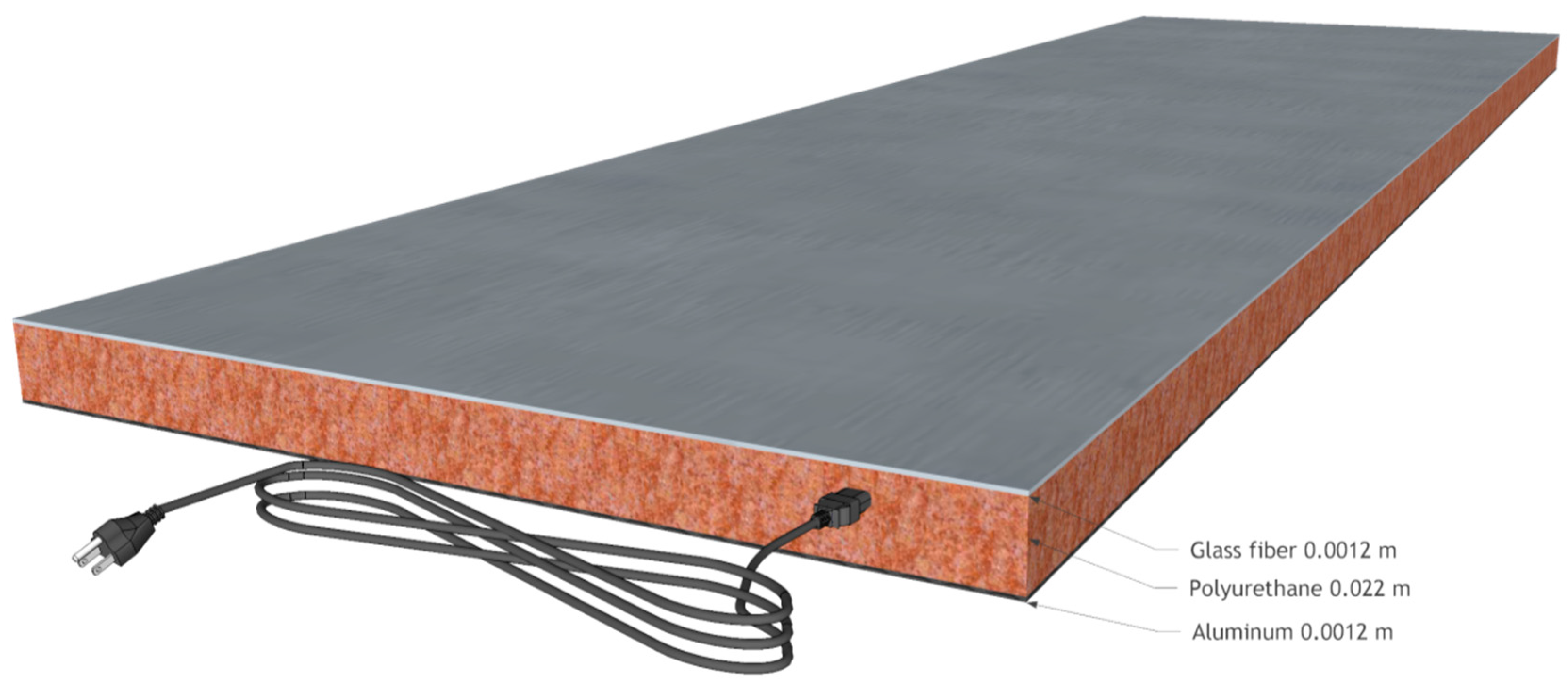
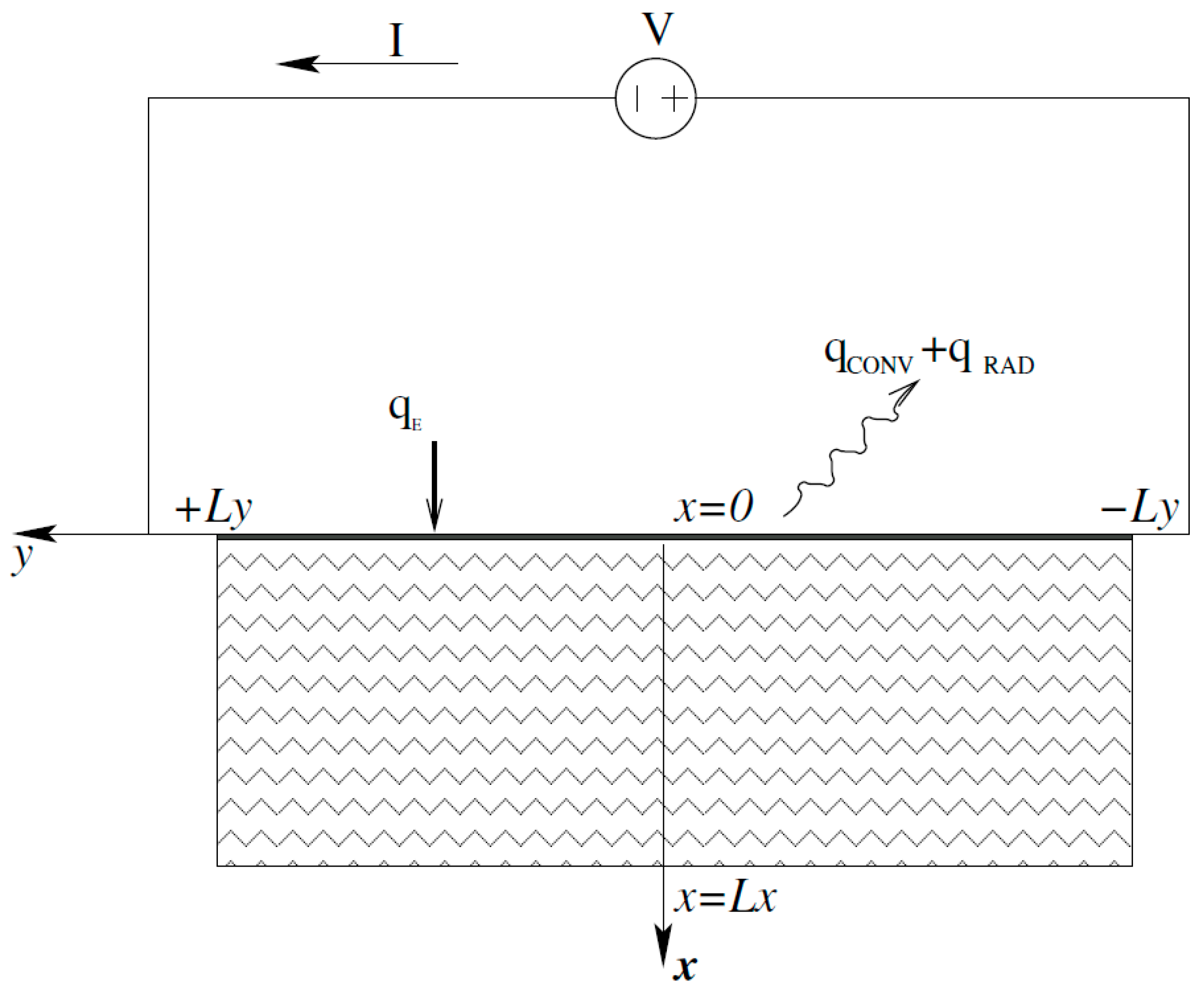

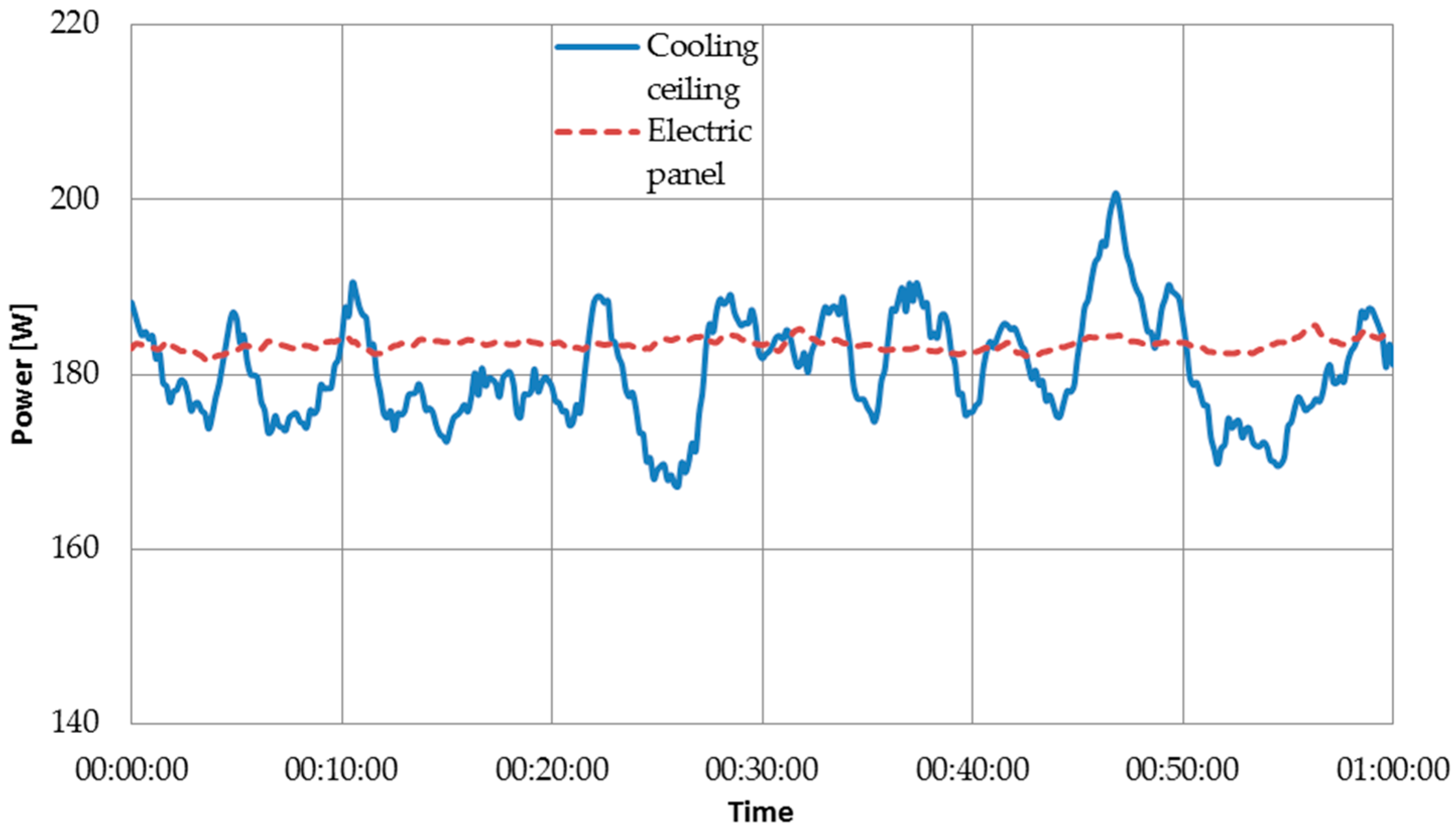
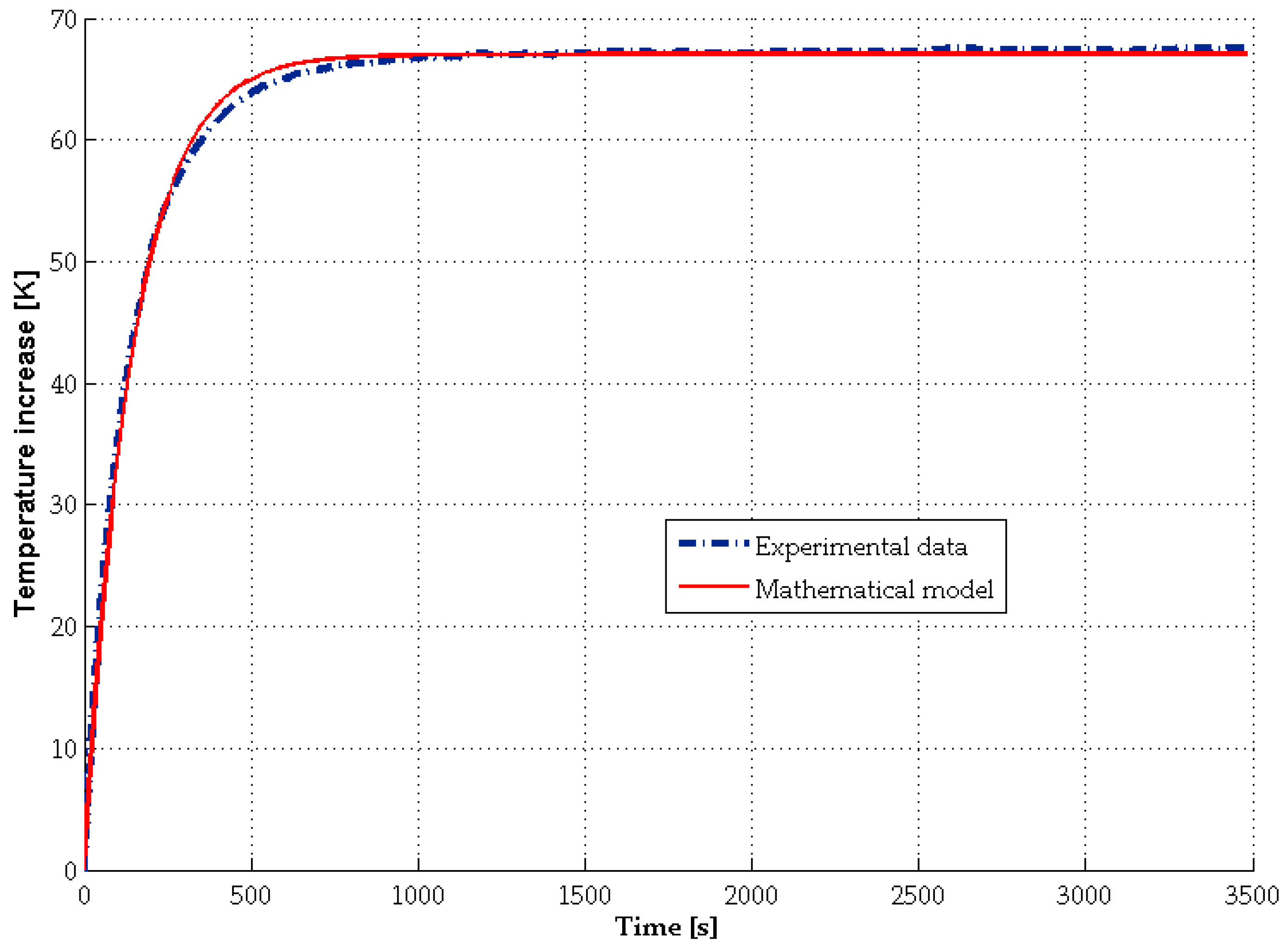
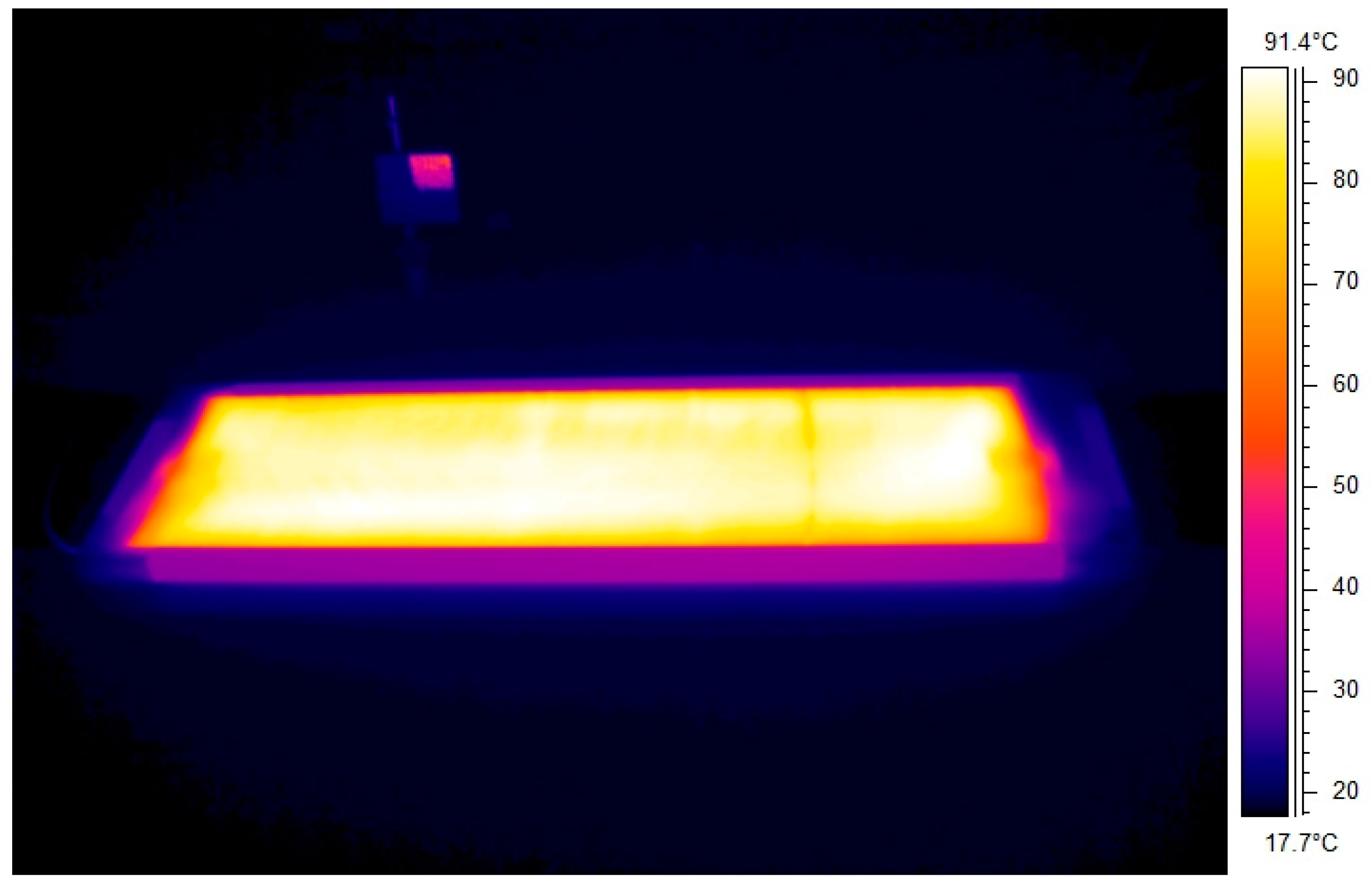
| Layer | Material | Thickness [mm] | Density [kg m−3] | Specific Heat [J kg−1 K−1] | Thermal Conductivity [W m−1 K−1] |
|---|---|---|---|---|---|
| Front | Glass fiber | 1.2 | 2500 | 800 | 1.1 |
| Middle | Polyurethane foam | 22.0 | 40 | 1480 | 0.03 |
| Rear | Aluminum metal sheet | 1.2 | 2700 | 800 | 170 |
| Type of Measurement | Instrument | Quantity |
|---|---|---|
| Water temperature | Resistance Temperature Detector Pt100 | 4 |
| Water Flow | Electromagnetic flowmeter | 1 |
| Electrical power | Volt-Ampere meter | 1 |
| Type of Measurement | Instrument | Quantity |
|---|---|---|
| Wall temperature | Resistance Temperature Detector Pt100 | 13 |
| Air temperature | Resistance Temperature Detector Pt100 | 9 |
| Water temperature | Resistance Temperature Detector Pt100 | 2 |
| Mean radiant temperature | Globe thermometer | 2 |
| Heat flux | Heat flux meter | 1 |
© 2018 by the authors. Licensee MDPI, Basel, Switzerland. This article is an open access article distributed under the terms and conditions of the Creative Commons Attribution (CC BY) license (http://creativecommons.org/licenses/by/4.0/).
Share and Cite
Ferrarini, G.; Fortuna, S.; Bortolin, A.; Cadelano, G.; Bison, P.; Peron, F.; Romagnoni, P. Numerical Model and Experimental Analysis of the Thermal Behavior of Electric Radiant Heating Panels. Appl. Sci. 2018, 8, 206. https://doi.org/10.3390/app8020206
Ferrarini G, Fortuna S, Bortolin A, Cadelano G, Bison P, Peron F, Romagnoni P. Numerical Model and Experimental Analysis of the Thermal Behavior of Electric Radiant Heating Panels. Applied Sciences. 2018; 8(2):206. https://doi.org/10.3390/app8020206
Chicago/Turabian StyleFerrarini, Giovanni, Stefano Fortuna, Alessandro Bortolin, Gianluca Cadelano, Paolo Bison, Fabio Peron, and Piercarlo Romagnoni. 2018. "Numerical Model and Experimental Analysis of the Thermal Behavior of Electric Radiant Heating Panels" Applied Sciences 8, no. 2: 206. https://doi.org/10.3390/app8020206





